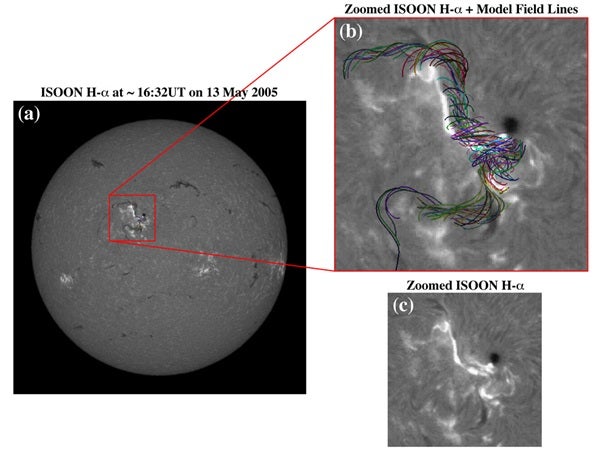An international group of solar and space scientists has built the most complete picture yet of the full impact of a large solar eruption, using instruments on the ground and in space to trace its journey from the Sun to Earth.
Coronal mass ejections (CMEs) are giant eruptions of the Sun’s atmosphere from its surface that are ejected out into space. The eruptions are many times larger than Earth and typically contain over a billion tons of matter. CMEs travel away from the Sun at speeds of up to several million miles per hour, and they can impact comets, asteroids, and planets, including Earth.
Our planet is normally protected from CMEs by the terrestrial magnetic field, but the twisted magnetic fields carried by CMEs can break through this protective shield, causing particles to stream down over Earth’s polar regions. They also can lead to displays of the northern and southern lights (aurora borealis and australis). But CMEs also can have less appealing consequences such as power outages on the ground, interference with communications, damage to Earth-orbiting satellites, as well as being a possible health risk to astronauts who happen to be conducting a “space walk” at the time an event interacts with Earth.
So scientists came together to study one event in great detail in an attempt to gain an enhanced understanding of CMEs and to gain insight into their prediction and, more importantly, when and how they may interact and cause effects on and in the vicinity of Earth. After a painstaking analysis of the observations and measurements from all the different spacecraft and facilities on the ground, they have assembled an incredibly detailed picture.
They chose an eruption that lifted off the Sun May 13, 2005, and headed in our direction. As it approached our planet, it interacted with the solar wind, the material that is constantly flowing out from the Sun at relatively steady rates. This particular CME deflected some of the solar wind northward as it headed in the direction of Earth and was itself slowed as a result of the solar wind ahead of it.
The mass expelled in the event was not that different from many other solar eruptions, but its magnetic field was very intense, and, as such, this event caused the largest geomagnetic storm — rapid changes in the shape and strength of Earth’s magnetic field — during 2005. At that time, solar activity was in decline from the maximum period between 2002 and 2004 to the recent minimum between 2008 and 2010.
At the start of the event, the outburst was thought to be a simple CME, but the unprecedented coverage revealed it to be extremely complex. The event was caused by multiple flare-type events near the solar surface that released magnetic energy and mass out into the solar wind in the form of the CME.
The material then traveled through interplanetary space toward Earth — in this phase it is described as an Interplanetary CME or ICME. With the magnetic field frozen inside it in the form of a “flux rope,” or “magnetic cloud” (MC), when the ICME reached our planet it began to compress Earth’s magnetic field into a distance of about 24,000 miles (38,000 kilometers) — in comparison, the field on the sunward side would normally extend to 59,000 miles (95,000 km). The arrival of the CME also caused some minor effects on satellites and communications as well as wonderful auroral displays.
Mario Bisi of Aberystwyth University, United Kingdom, sees the new analysis as a key step forward in our understanding of the way solar eruptions develop and affect Earth. “We learned an enormous amount from the 2005 event. Even an apparently simple CME turned out to be incredibly complex,” said Bisi. “And the intense reaction of Earth’s magnetic field to a fast but not particularly powerful event was a surprise.”
“We’re now also much better prepared for future events and, if nothing else, know how to handle such a large amount of data,” Bisi said. “All of this adds to our knowledge of the way CMEs originate, develop, and sometimes even have an impact on everyday life.”










